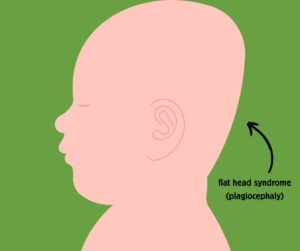Becoming a new parent is a thrilling experience, filled with many firsts and precious moments. However, it also comes with its fair share of worries, especially regarding your baby’s health and development. One area that often raises concerns is the physical well-being of infants, particularly issues like torticollis and flat head syndrome. Understanding these conditions and knowing when to seek professional help can significantly impact your baby’s growth and comfort.
Physiotherapy can be a game-changer for addressing physical ailments from an early age. If you’ve noticed that your baby has difficulty turning their head or has developed a flat spot on their head, visiting a physiotherapist can be highly beneficial. Early intervention can prevent long-term issues and promote healthy development.
What are Torticollis and Flat Head Syndrome?

Torticollis
Torticollis, also known as “wry neck,” is a condition where a baby’s neck muscles are tight, causing their head to tilt to one side. This can be due to positioning in the womb or a difficult birth.

Flat Head Syndrome
Flat head syndrome, or plagiocephaly, occurs when a baby’s head develops a flat spot due to prolonged pressure on one part of the skull. This often happens when babies spend a lot of time lying on their backs.
Both conditions can lead to discomfort and developmental delays if not addressed early.
Signs and Symptoms to Look For
Knowing the signs and symptoms of these conditions is crucial for early detection and intervention. Here’s what to watch for:
Torticollis:
- Head tilted to one side.
- Limited neck movement
- Difficulty turning head in both directions or prefer looking in one direction.
- One shoulder higher than the other
- Difficulty breastfeeding on one side
Flat Head Syndrome:
- Noticeable flat spot on the back or side of the head
- Facial asymmetry
- Misaligned ears
- Bald spot in one area
If you notice any of these symptoms, it’s essential to consult a healthcare professional who can provide an accurate diagnosis and recommend appropriate treatment.

The Importance of Early Intervention and Physiotherapy
Early intervention is critical to treating torticollis and flat head syndrome effectively. The sooner these conditions are addressed, the better the outcomes will be. Physiotherapy plays a vital role in treating these conditions by:
- Improving Range of Motion: Physiotherapists use specific exercises to stretch and strengthen the neck muscles, enhancing movement and flexibility.
- Promoting Symmetrical Development: Guided exercises and positioning strategies help ensure your baby’s head and neck develop evenly.
- Enhancing Motor Skills: Addressing these issues early can support overall motor development, helping your baby reach milestones more smoothly.
When is it Too Late for Treatment?
While early intervention is ideal, it’s never too late to seek treatment. Physiotherapists can work with children of all ages to address these conditions, although the earlier you start, the quicker and more effective the treatment tends to be. Treatment for a flat head is less effective after 14 months of age.
Risks of Not Getting Treatment
Failing to address torticollis and flat head syndrome can lead to:
- Permanent facial and skull asymmetry
- Delayed motor skill development
- Persistent neck and back issues

Tips to Prevent Torticollis and Flat Head Syndrome
Prevention is always better than cure. Here are some practical tips to help prevent these conditions:
- Tummy Time: Ensure your baby spends time on their tummy while awake to strengthen neck muscles and reduce pressure on the head.
- Alternate Head Positions: Encourage your baby to turn their head in different directions by alternating which arm you carry them in and which direction you approach them from.
- Vary Sleeping Positions: Alternate your baby’s direction in the crib to prevent favouring one side.
- Limit Time in Car Seats and Carriers: Reduce the time your baby spends in positions that put pressure on their head.
- Use a Supportive Mattress: A firm, flat mattress can help distribute pressure more evenly.
- Use a Support Pillow: Specially designed pillows can help maintain the shape of your baby’s head while sleeping.
Choosing a Physiotherapist
Finding the right physiotherapist is crucial. Look for a professional who specializes in pediatric care and shows a commitment to patient-centred treatment. The therapist’s primary role should be to educate you about your baby’s condition and the treatment options available. If you don’t feel comfortable asking questions or if you leave an appointment feeling confused, consider finding another therapist who better meets your needs.
What to Expect During a Visit
- Initial Assessment: The physiotherapist will thoroughly evaluate your baby’s condition, including a physical examination and a review of medical history.
- Treatment Plan: Based on the assessment, a customized treatment plan will be developed, including exercises, stretches, and positioning techniques.
- Parent Education: You’ll receive guidance on performing exercises at home and tips for daily care to support your baby’s progress.
Conclusion
Monitoring your baby’s development is crucial for their overall health and well-being. If you notice any signs of torticollis or flat head syndrome, seeking professional help early can prevent long-term issues and support your baby’s growth. Remember, you’re not alone on this journey. At Newleaf Total Wellness Centre, we’re here to partner with you in taking proactive steps toward a higher quality of life for your little one.
—
Following these guidelines and seeking early intervention can help ensure your baby’s healthy development and well-being. If you have any questions or want to book an appointment, please get in touch with Newleaf Total Wellness Centre today.

